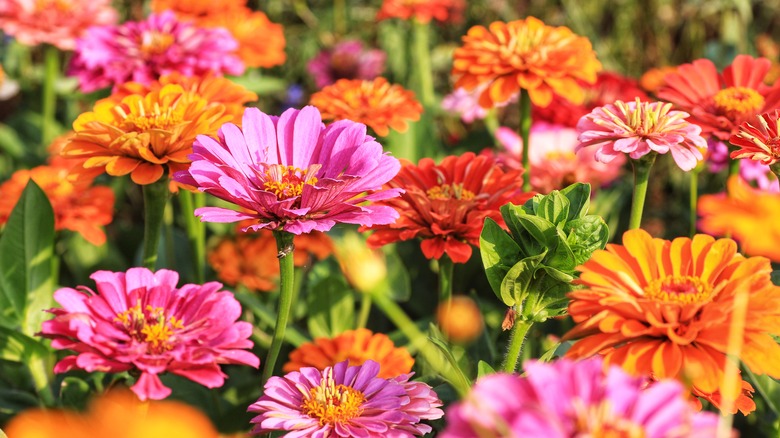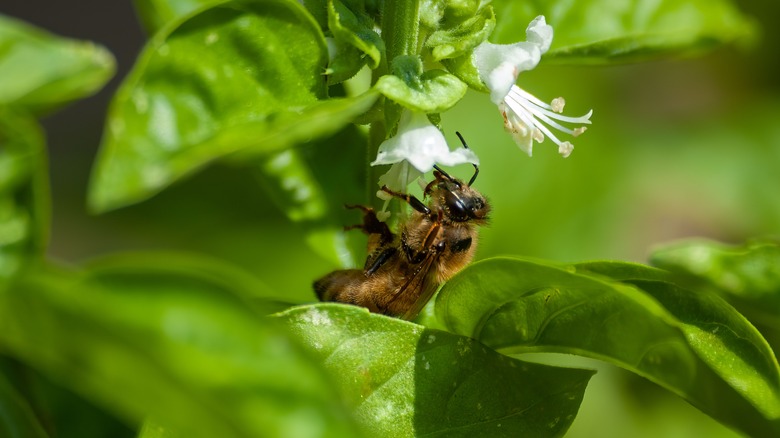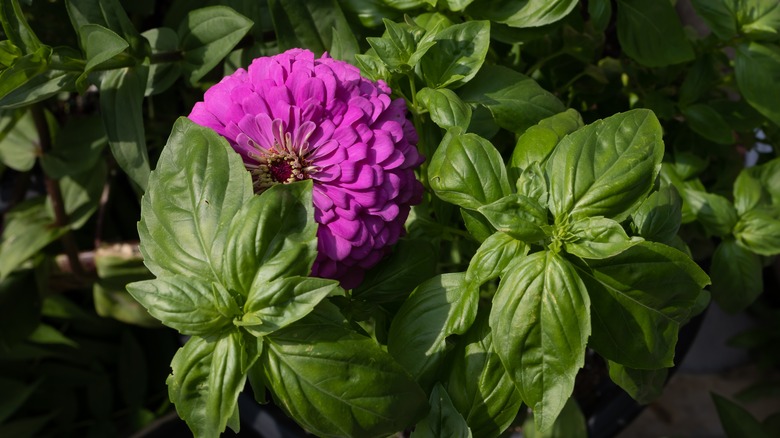The Delicious Herb You Should Plant Next To Zinnias In The Garden
The zinnia, a typically low-maintenance garden flower, is a fantastic bloomer. It does well in most conditions, even when the sun gets too hot or the soil dries out, that other plants can tolerate. These flowers are noted for their bright colors and for adding stunning foliage to your flowerbeds, but they could use a bit of help to reach their true potential. Planting zinnias with other plants to support their need for significant pollination is best. One specific plant that grows happily with zinnias is basil.
Companion planting is the process of placing two plants next to each other to support the other's needs. It is a tried-and-true way of creating a thriving garden. With the addition of basil, you get more bright blooms and a bit of fresh basil to add to your favorite dishes. Consider planting basil and zinnias right in your vegetable garden. The basil will help support pollinators for your tomatoes, peppers, and beans – while the zinnia helps add deep green foliage and bursts of color to your garden throughout the season — also attracting pollinators. Not only does this type of companion planting lead to fantastic opportunities for fresh vegetables, but the zinnias are fantastic as cut flowers you can bring inside throughout the growing season to add beauty to your home. With so many colors available through the various zinnia species, you'll likely have plenty of options to consider.
How basil can support your zinnias growth and blooms
Basil is an excellent companion plant for zinnias for several reasons. First, it's a fantastic pollinator, drawing in bees and birds to help provide the necessary pollination to support the zinnia's blooms. This often allows for extending the blooming season as well — from the first weeks of summer and through the fall until the first frost. Basil and zinnias also need the same basic conditions to thrive. Preferring full sun for 6 to 8 hours a day. Keep in mind that you'll need some space between the two since zinnias can grow tall and limit sun exposure to shorter basil planted too close. Both plants do well with sun and heat, but when there's too much shade or moisture that doesn't dissipate fast enough, both plants are susceptible to mildew and fungus growth. By creating a supportive environment, both of these plants should thrive.
Basil needs well-drained soil with an organic makeup and ample nutrients. Those organic nutrients help the basil plant fill out with healthy leaves, adding a secondary benefit of companion flavoring (which can benefit your nearby tomatoes). Zinnias also benefit from strong, organic-based soil with a pH balance between 5.5 and 7.5 for the best results. Because their needs are closely matched, you can plant them in the same planter (with enough space between them) or next to each other in a garden or flowerbed.
Strategies for getting the best out of a zinnia and basil garden
With numerous types of zinnias available in North America, you must learn as much as you can about each variety's specific needs when engaging in companion planting like this. The most popular variety, Zinnia elegans, is typically the best choice for planting in a flowerbed when you want statement blooms and several variations of flower shapes, including the beehive and button-style flowers. To achieve this, they need pollination, so plant your basil within a few feet of the zinnias. Ensure there's ample air circulation present, which also means trimming back the base stems to allow the ground to remain open.
You can plant both zinnias and basil around the same time, in late spring, after the threat of frost. You can grow either from seed or purchase starter plants locally. Be creative with your planting. For example, if you have a long window box, place one of each plant in the window box to allow for the perfect view each day. Zinnias need about 6 inches of space from one another, while basil benefits from at least 4 inches and up to 8 inches of space, making this the perfect choice for container gardening. Both plants can be picked and harvested throughout the year, allowing new buds to form continuously. Though they are annuals, lasting only a year, they are an excellent choice for many gardens.


